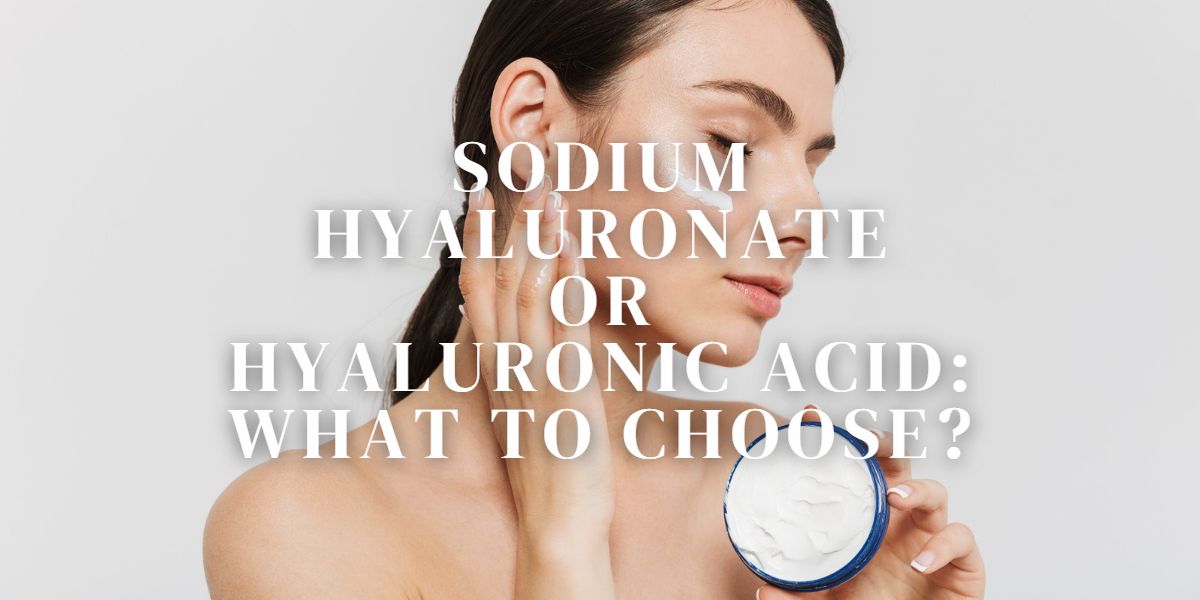Sodium Hyaluronate or Hyaluronic Acid: What to Choose?
Jump To:
If you’re curious about incorporating hydrating and plumping ingredients into your beauty routine, you may have come across sodium hyaluronate and hyaluronic acid. Both of these ingredients are popular choices for their ability to hold large amounts of water, which can help to hydrate and plump up the skin. But with so many options available, it can be confusing to know which one is best for your needs.
In this blog, we’ll take a closer look at sodium hyaluronate and hyaluronic acid, comparing their benefits, differences, and potential side effects. By the end of this article, you’ll have a better understanding of these two skincare ingredients and how to choose the one that’s right for you.
Hyaluronic acid
Hyaluronic acid is a substance that is naturally produced by the body and is present in the skin, eyes, and joints. It is famous for its ability to retain water, which helps to keep the skin hydrated and plump.
In skincare products, hyaluronic acid is often used to improve the appearance of fine lines and wrinkles, as well as to improve the skin’s texture and tone. It is a larger molecule than sodium hyaluronate, which means it sits on the surface of the skin rather than penetrating it. This can make it a good choice for those with sensitive skin, as it is less likely to cause irritation.
In addition to its hydrating properties, hyaluronic acid is also thought to have antioxidant and anti-inflammatory effects, which can help to protect the skin from environmental stressors and calm irritation. It is often used in conjunction with other skincare ingredients, such as antioxidants and skin-repairing agents.
Overall, hyaluronic acid is a popular and effective skincare ingredient that can help to improve the health and appearance of the skin.
Hyaluronic acid: skin benefits
Hyaluronic acid is a popular skincare ingredient that is known for its ability to hold large amounts of water, which can provide a range of benefits for the skin. Some of the potential benefits of using hyaluronic acid on the skin include:
- Hydration
- Improved skin texture
- Reduced appearance of fine lines and wrinkles
- Improved skin tone
- Protective barrier
It’s important to note that the effectiveness of hyaluronic acid can vary depending on the specific product and formulation, as well as the individual’s skin type and concerns. It’s always a good idea to consult with a dermatologist or beauty professional to determine the best course of action for your individual needs.
Hyaluronic acid: potential side effects
Hyaluronic acid is generally a safe and effective skincare ingredient, with few reported side effects. However, as with any beauty product, it is possible to experience some mild side effects when using products containing hyaluronic acid.
Some potential side effects of using hyaluronic acid on the skin may include:
- Dryness
- Redness
- Breakouts
- Allergic reactions
It’s important to note that the likelihood and severity of side effects can vary depending on the specific product and formulation, as well as the individual’s skin type and concerns.

Sodium hyaluronate
Sodium hyaluronate is the salt form of hyaluronic acid. The molecular size of sodium hyaluronate is much smaller than hyaluronic acid, which means it is able to penetrate the skin more easily.
Sodium hyaluronate is often used in beauty products for its ability to hold large amounts of water, which helps to hydrate and plump up the skin. It has the ability to improve the appearance of fine lines and wrinkles. It also helps to enhance the skin’s elasticity and firmness.
In addition to its hydrating properties, sodium hyaluronate is also a gentle ingredient that is suitable for those with sensitive skin. It is non-irritating and has a low risk of causing allergic reactions.
Overall, sodium hyaluronate is a versatile and effective beauty ingredient that can help to improve the overall health and appearance of the skin. It is often present in a variety of beauty products, including serums, creams, and facial masks.
Sodium hyaluronate: skin benefits
Sodium hyaluronate is a form of hyaluronic acid, a substance that occurs naturally in the human body. It is a type of glycosaminoglycan. Glycosaminoglycan is a long chain of sugars that is present in the skin, joints, and other tissues. Sodium hyaluronate is often present in skin care products as it can hold onto moisture, making it a good humectant.
There are several potential benefits of using sodium hyaluronate in skin care products:
- Moisturizing
- Anti-aging
- Healing
- Reducing inflammation
Overall, sodium hyaluronate is a safe and effective ingredient that can improve the appearance and health of the skin. It is widely present in a variety of skincare products, including moisturizers, serums, and facial masks.
Sodium hyaluronate: potential side effects
Sodium hyaluronate is generally safe and well-tolerable when used in skin care products. Some people may experience mild side effects after using products containing sodium hyaluronate, such as:
- Some people may experience redness or irritation when using products containing sodium hyaluronate, especially if they have sensitive skin.
- In rare cases, people may develop a rash after using products containing sodium hyaluronate. This is usually a sign of an allergic reaction. We recommend you consult a dermatologist under such circumstances.
- Some people may experience itching after using products containing sodium hyaluronate, especially if they have sensitive skin.
Overall, the side effects of sodium hyaluronate are typically mild and temporary. If you experience any side effects, we recommend you stop using the product and consult a healthcare professional if necessary.
Can you use these skincare ingredients together?

Yes, it is possible to use hyaluronic acid and sodium hyaluronate together. In fact, many skin care products contain both of these ingredients.
Hyaluronic acid is a natural substance that is present in the skin, and it helps to keep the skin hydrated and plump. Sodium hyaluronate does the same on a deeper level. Sodium hyaluronate is the ingredient that is actually extracted from hyaluronic acid. It has been chemically modified to make it more stable and easier to incorporate into skin care products.
Both hyaluronic acid and sodium hyaluronate have the ability to attract and hold onto water. This makes them effective at helping to moisturize the skin. They also have anti-aging effects, as they can help to reduce the appearance of fine lines and wrinkles.
Using hyaluronic acid and sodium hyaluronate together can provide even more hydration, as the two ingredients work together to attract and hold onto water in the skin. However, it is important to follow the instructions on the product packaging and use the product as directed, as overuse or improper use of these ingredients can potentially lead to skin irritation or other negative side effects.
Wrapping up
Sodium hyaluronate and hyaluronic acid are both effective ingredients for improving the hydration and overall health of the skin. However, they differ in their molecular size and ability to penetrate the skin. Sodium hyaluronate is a smaller molecule than hyaluronic acid, which allows it to penetrate the skin and deliver intense hydration. Hyaluronic acid, on the other hand, is a larger molecule that sits on top of the skin, providing a surface-level moisturizing effect.
Both ingredients have their own unique benefits. Sodium hyaluronate is ideal for those with dry or dehydrated skin. It provides intense hydration and improves the skin’s overall texture and appearance. Hyaluronic acid is suitable for all skin types and is especially helpful for those with mature skin. It can help to reduce the appearance of fine lines and wrinkles.
Ultimately, the choice between sodium hyaluronate and hyaluronic acid comes down to personal preference. It may be helpful to try both and see which one works better for you. You can also use a product that combines both ingredients for maximum hydration and skin-plumping effects.

